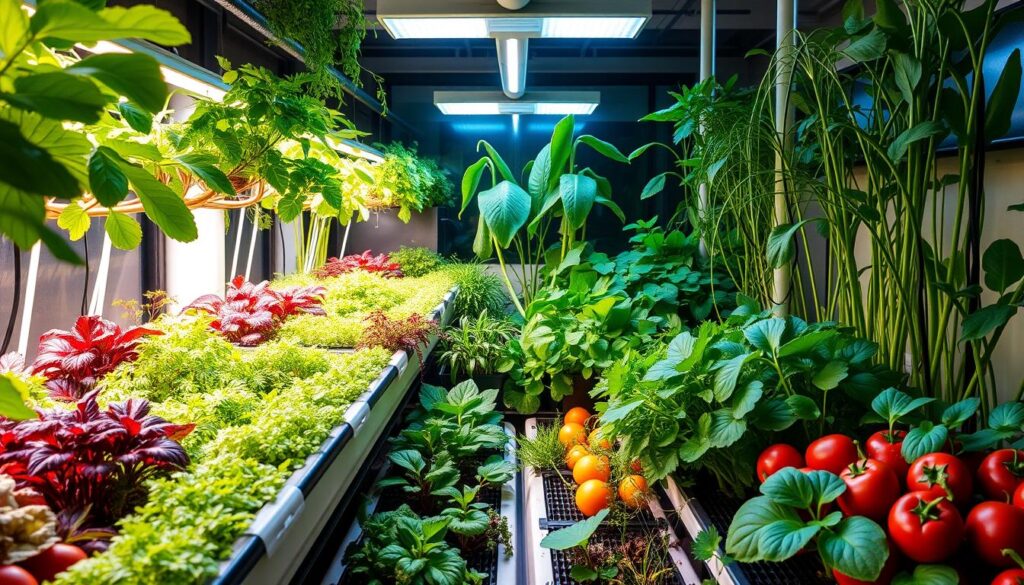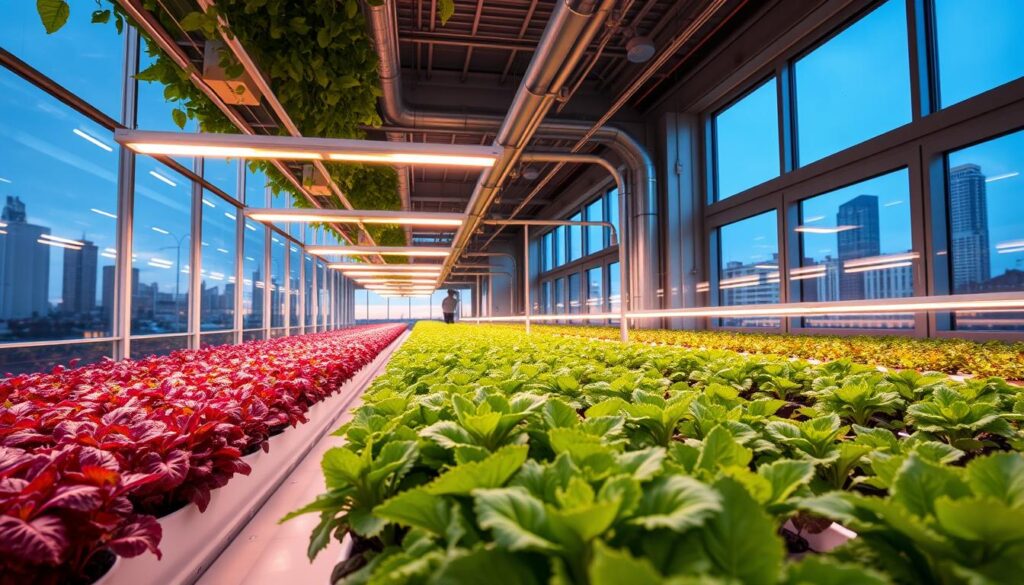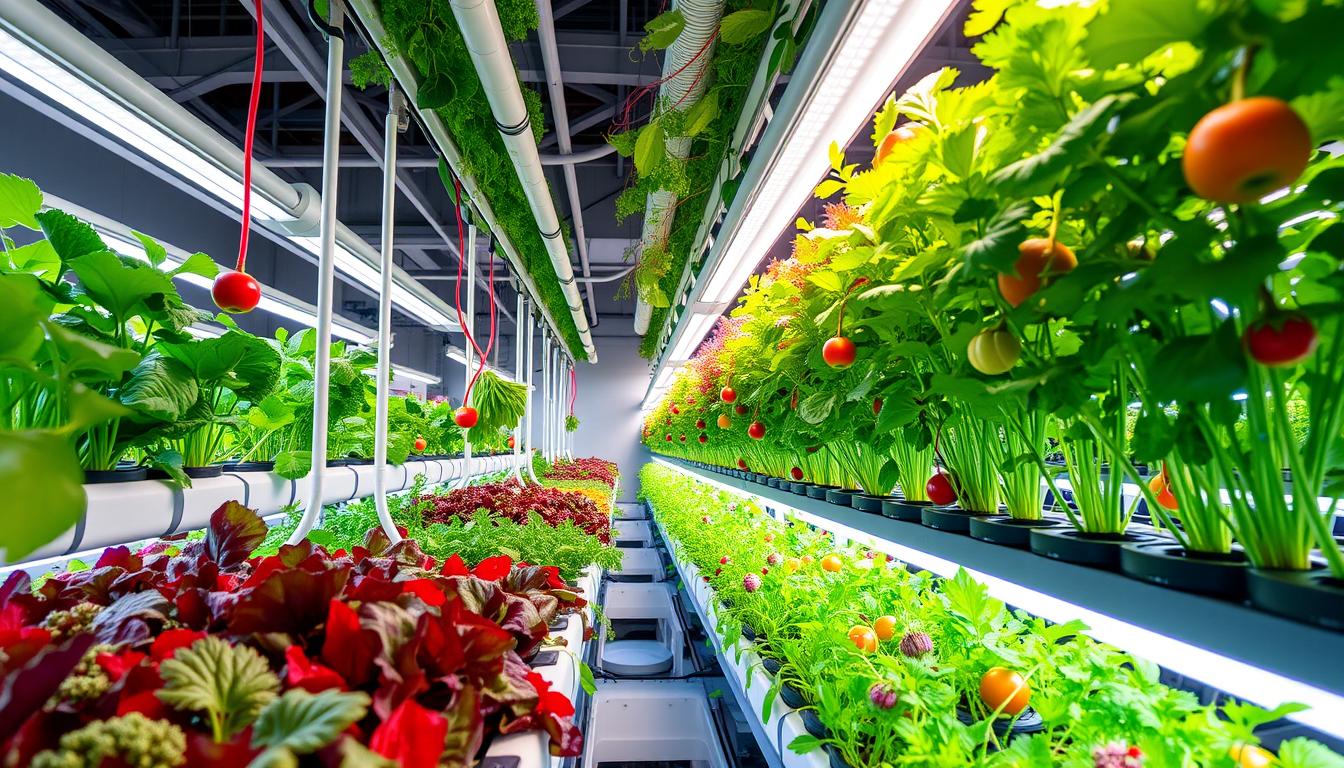Hydroponic gardening brings many benefits, like more crops and saving water. It’s a great choice for farmers and gardeners. This method is popular because it uses less land and delivers nutrients well.
Hydroponic gardening has many benefits. It helps the environment and grows high-quality crops. The future of farming is indeed hydroponic.
Introduction to Hydroponic Gardening
We’ll look into the advantages of hydroponic gardening. We’ll talk about its benefits and how it changes farming.
Key Takeaways
- Hydroponic gardening offers numerous benefits, including water conservation and increased crop yields.
- Hydroponic gardening advantages include reduced land use and efficient nutrient delivery.
- Hydroponic farming benefits the environment by reducing waste and conserving resources.
- Hydroponic gardening is a sustainable and efficient way to produce high-quality crops.
- The future of farming is hydroponic, with its numerous benefits and advantages.
Understanding the Benefits of Hydroponic Gardening
Hydroponic gardening grows plants without soil. It’s become popular for its benefits like more crops and better plant health. Hydroponic systems are a green and efficient way to grow plants.
Hydroponics saves water, using much less than traditional farming. It also needs less land and costs less to work. These are big advantages for places where water is hard to find.
What Is Hydroponic Gardening?
Hydroponic gardening grows plants in a nutrient-rich solution, not soil. Plants get the nutrients they need and are supported by materials like rockwool. This method is flexible and works well for many plants.
How Hydroponics Differs from Traditional Farming
Hydroponics and traditional farming are different. Traditional farming uses soil for nutrients, while hydroponics uses a solution. This gives growers more control and can lead to faster growth and more crops.
The Science Behind Soil-free Growing
The science of growing without soil is about giving plants what they need. Hydroponic systems use a special solution that matches each plant’s needs. This leads to better growth and quality crops. Knowing how hydroponics works helps growers choose the best methods.
| Hydroponic System | Description |
|---|---|
| NFT (Nutrient Film Technique) | A continuous flow of nutrient-rich solution is pumped through the system. |
| DWC (Deep Water Culture) | Plants are suspended in a nutrient-rich solution, with their roots submerged in the solution. |
| Ebb and Flow | A periodic flooding and draining of the system, providing plants with a consistent supply of nutrients. |
#1 Superior Growth Rates and Yields
Hydroponic systems have many benefits, like faster growth and higher yields. They give plants just the right nutrients. This helps plants grow quickly and produce more.
This is great for those who grow crops for a living. It means they can make more money and spend less on labor.
Growing plants hydroponically has many advantages. Some key ones are:
- Increased crop yields
- Improved crop quality
- Reduced water usage
- Reduced land usage
Hydroponic growth is also more efficient. It lets growers control things like temperature and light. This creates the best conditions for plants to thrive.
So, hydroponic systems can grow crops that are not only more but also better. They have more nutrients too.
In summary, hydroponic systems offer many benefits. They help growers get better growth and yields. This leads to more money and less work.
#2 Water Conservation and Efficiency
Hydroponic gardening is great for saving water. It uses water much more efficiently than old farming ways. This is because it recirculates nutrient solutions and collects condensation.
Hydroponics is perfect for places where water is hard to find. It can use up to 90% less water than traditional farming. This makes it a good choice for those who care about water.
- Recirculating nutrient solutions to minimize water waste
- Using condensation collection systems to harvest water
- Implementing drip irrigation systems to deliver water directly to the roots
By using these water-saving methods, hydroponic growers help the environment. They also save money on water. As the world faces water shortages, hydroponics’ role in saving water is key.
| Method | Water Usage |
|---|---|
| Traditional Farming | High |
| Hydroponics | Low |
#3 Year-round Growing Capabilities
Hydroponic gardening lets you grow crops indoors all year. This method of indoor gardening with hydroponics gives you control over the growing space. This leads to better plant growth and more crops.
Hydroponic gardening means you can grow crops without soil. It’s great for places with bad soil or little space. Plants get all they need from a nutrient-rich solution.

- Increased crop yields
- Improved plant growth and health
- Reduced water usage and waste
- Year-round production, regardless of season or climate
With indoor gardening with hydroponics, you can have fresh produce all year. It’s also good for the planet. This way of growing crops without soil is changing how we grow food, and it’s making a big difference.
#4 Space Optimization and Vertical Farming Potential
Hydroponic vertical farming is a great solution for cities with little space. It lets farmers grow more food in less area. This is perfect for city farming, where space is a big challenge.
Some key benefits of hydroponic vertical farming are:
- More food per square foot
- Less water used and waste
- Better quality and consistent crops
- Growing food all year round
Urban farming with hydroponics works in many places. From small gardens to big farms, it’s all about using every inch. This way, people can grow their own food and help the planet.
For businesses, hydroponic vertical farming is a big opportunity. It lets companies grow fresh, local food all year. This meets the growing need for fresh produce.
| Method | Space Requirements | Crop Yield |
|---|---|---|
| Traditional Farming | Large areas of land | Lower yields per square foot |
| Hydroponic Vertical Farming | Small areas of land | Higher yields per square foot |
#5 Reduced Pest Problems and Chemical Usage
Hydroponic gardening has a big advantage when it comes to hydroponic pest control. Plants are grown in a controlled space, which lowers the chance of pests. This means less need for harmful chemicals. It’s better for the planet and makes crops healthier for us.
Hydroponics lets farmers use integrated pest management techniques. This means using many ways to fight pests, like introducing helpful bugs and using barriers. It’s a smart way to grow food that’s good for the planet and us.
Using fewer chemicals in hydroponics is key. It keeps our food and environment safe. Here are some ways to do it:
- Use natural pest control, like helpful insects
- Keep things clean, like washing equipment often
- Change what you grow to avoid pests
By doing these things, farmers can grow food in a way that’s better for our planet. This makes our food healthier and more sustainable for everyone.
| Pest Control Method | Description | Benefits |
|---|---|---|
| Integrated Pest Management | Combination of methods to control pests | Reduces chemical usage, minimizes environmental impact |
| Natural Pest Control | Introduction of beneficial insects | Safe for environment, effective against pests |
| Good Hygiene Practices | Regular cleaning and sanitation | Reduces risk of pest infestations, ensures food safety |
#6 Enhanced Nutritional Control and Food Quality
Hydroponic gardening gives growers a special edge in controlling nutrients and food quality. It lets them manage the nutrients their crops get. This ensures plants get exactly what they need to grow well.
The health benefits of hydroponic produce are many. People say it tastes better and is healthier. This is because hydroponic crops grow in a clean environment, away from harmful substances.
- Increased crop yields
- Improved plant health
- Enhanced nutritional value
- Reduced water usage
Choosing hydroponic gardening means better food quality and helping the planet. It’s a sustainable way to grow crops.
As more people want healthy food, hydroponics will be key. It offers better nutrition and quality, making it great for the environment and our health.
#7 Labor and Maintenance Efficiency
Hydroponic gardening brings many benefits, including hydroponic labor efficiency. It allows growers to design systems that need less labor and upkeep. This way, they can focus on other important parts of their work. One key method is using automated hydroponic systems. These systems keep an eye on things like pH, temperature, and nutrient levels.
Some big pluses of reduced maintenance in hydroponics are:
- Less time spent on manual labor
- Improved crop yields and quality
- Reduced risk of human error
Thanks to automated hydroponic systems, growers can make their operations better. This leads to more productivity, lower costs, and a greener farming way.
#8 Environmental Impact and Sustainability
Hydroponic gardening is great for the environment, making it a top choice for eco-conscious people. It helps reduce our ecological footprint. By using sustainable hydroponic gardening, we can make food production more green. This method also helps fight climate change by lowering our carbon footprint.
Hydroponic systems save water and use resources wisely. This gardening method also protects the soil by avoiding tillage. Plus, it cuts down on waste by recycling nutrients and using fewer chemicals.
- Reduced land use and soil erosion
- Conservation of water resources
- Minimized use of chemical pesticides and fertilizers
- Increased crop yields and improved food quality
Choosing sustainable hydroponic gardening helps us create a greener food system. It leads to a lower carbon footprint and a more sustainable world.
#9 Economic Advantages for Commercial Growers
Commercial hydroponic gardening brings many economic benefits. It’s a great choice for growers. The main advantage is lower labor costs thanks to automated systems. This means growers can use their resources more wisely, leading to higher profits.
Some key advantages of commercial hydroponic gardening include:
- Reduced water consumption, resulting in lower water bills
- Improved crop yields, leading to higher revenue
- Extended growing seasons, allowing for year-round production
- Reduced land use, making it ideal for urban areas
By using hydroponic systems, commercial growers can see their profits rise. They also become more efficient. This method also helps reduce waste and improves how resources are used. As people look for more sustainable farming, hydroponic gardening is becoming a top choice.

| Benefits | Hydroponic Gardening | Traditional Farming |
|---|---|---|
| Water Consumption | Reduced | High |
| Crop Yields | Improved | Variable |
| Land Use | Reduced | High |
Understanding the economic benefits of hydroponic gardening helps growers make better choices. With its many advantages, like higher profits and lower labor costs, it’s a smart choice for commercial growers.
Getting Started with Hydroponic Systems
Starting a hydroponic garden can be thrilling and a bit scary for beginners. It’s important to know what you need and plan well to get good results. You’ll need a grow chamber, nutrient solution, and a pH test kit to begin.
Thinking about the cost of hydroponic systems is key. The initial cost might seem high, but these systems can save water and increase yields over time. This makes them a smart choice for both home gardeners and commercial growers.
Basic Equipment Needs
- Grow chamber or hydroponic system
- Nutrient solution and pH test kit
- Water pump and aeration system
- Grow medium, such as rockwool or coco coir
Common Beginner Mistakes to Avoid
Beginners often make mistakes that can cost time and money. Common errors include overwatering, underwatering, and not checking pH levels. Knowing these mistakes can help you avoid them and grow a successful crop.
| Equipment | Cost | Description |
|---|---|---|
| Grow chamber | $100-$500 | A container for the hydroponic system |
| Nutrient solution | $20-$50 | A balanced fertilizer for hydroponic plants |
| pH test kit | $10-$30 | A tool for monitoring pH levels |
Conclusion: Embracing the Future of Sustainable Agriculture
Hydroponic gardening is changing farming for the better. It lets growers get better growth, save water, and grow food all year. Plus, it cuts down on pests and makes food healthier.
The need for sustainable agriculture will grow as we face food security issues. Hydroponic gardening is a key solution. It lets us grow more food in less space, efficiently and with less harm to the environment. This method can be used everywhere, from city rooftops to big farms.
By using hydroponic gardening, we can create a future with plenty of nutritious food. As more people want food that’s good for the planet, now is the time to see how this technology can change farming.





